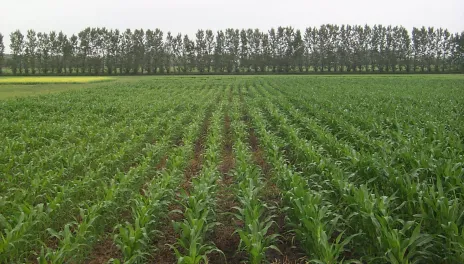Maximizing Corn Profitability
Hello! I hope you’re doing well!
We received over 10 inches of snow this past week. The high temperature for the past week ranged from 22 to 50 degrees Fahrenheit with an average of 32 degrees Fahrenheit. That average is 25 degrees lower than the 57 degrees Fahrenheit average we should be having. What a cold week. The forecast for the coming week looks to be below normal again.
Temperature, rainfall, and radiation are the major environmental factors that influence the growth and yield of corn.
The potential productivity of corn also is directly related to the length of the growing season. The longer the growing season, the longer the corn plant has to photosynthesize and accumulate dry matter for grain yield. Growing Degree Day (GDD) accumulations (normal values) for May 1 to October 1 vary considerably in the state, from more than 2,400 GDD in the southeast to fewer than 1,700 GDD in the north. Matching the maturity length of a corn hybrid with the likely GDD accumulations at a given location is one of the basic management practices for producing corn successfully. Our area has about 2,015 GDD.
Yield losses due to water stress can be significant when water stress occurs between silking and the early dent stage. When corn plants are water stressed during silking silks grow little, if at all, During the days when water transpiration is high. Under severe stress, some plants will not for any silks, or silks will emerge after pollen production has ceased, resulting in barren or partially fertilized ears. Drought stress during grain filling also can weaken stalks and predispose plants to stalk rots and lodging.
Selecting the right hybrid is a critical step for achieving high yields and sustainable production. The selection process can be challenging because many commercially available corn hybrids are adapted for use in North Dakota. Moreover, because of the rapid genetic improvement achieved by corn breeders, most hybrids remain in the market for fewer than five years, selecting new hybrids will be required regularly, if not every season. Grain yield is obviously one of the most important factors to consider in selecting a hybrid. Important criteria to consider when selecting a hybrid are yield, yield stability, maturity, specialty traits, disease resistance and stalk quality. To the extent possible, use impartial information based upon local research about the hybrids under consideration.
When not constrained by moisture stress, later-maturing hybrids usually have higher grain yield potential than earlier-maturing ones. However, hybrids that are too late for a given environment will have excessive grain moisture at harvest or may not reach physiological maturity in some seasons. The northern half of our county should grow between 75 and 85 relative maturity hybrids. The southern half of the county should grow between 85 and 90 relative maturity hybrids.
Building high yield potential in a corn crop starts with plating early. For most of the state, planting early means during the first part of May. Early planting is recommended because the risk of fall frost damage to the crop yield and quality is greater with each day planting is delayed.
Corn seed can be sown successfully after a wide range of pre-seeding tillage practices. Conventional, strip, and zero-tillage practices all are used in the state. In addition, an ideal seedbed should conserve moisture, have good soil to seed contact, control weeds, improve or preserve soil tilth and not be susceptible to wind and water erosion.
Recent data conducted in the northern corn belt suggest that in regions not prone to drought stress, narrower rows (15 inches to 22 inches) do offer a slight advantage in yield of about 2% to 5%.
For most regions of the state and for most hybrids 29,000 to 35,000 seeds per acre is a reasonable range to consider when establishing a seeding rate. For most drought prone areas in North Dakota the recommended population is between 16,000 and 25,000.
In most circumstances, corn should be planted 1.5 to 2 inches deep. Planting too shallowly (less than 1 inch) can result in the early nodal roots to be shallow and not properly located to supply the corn plant with nutrients and water.
